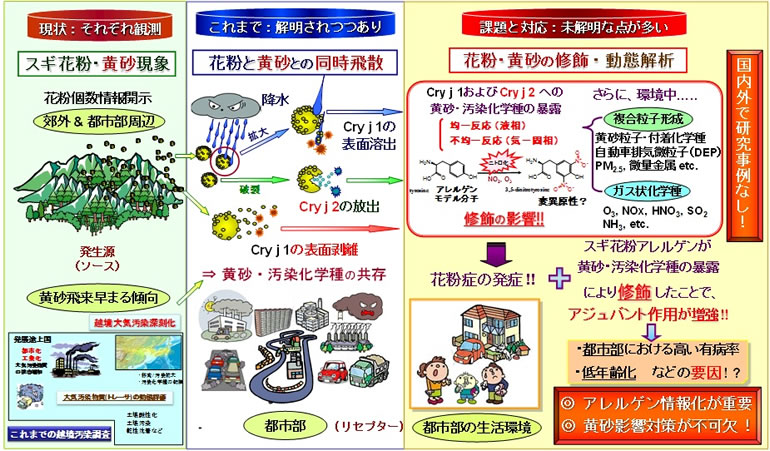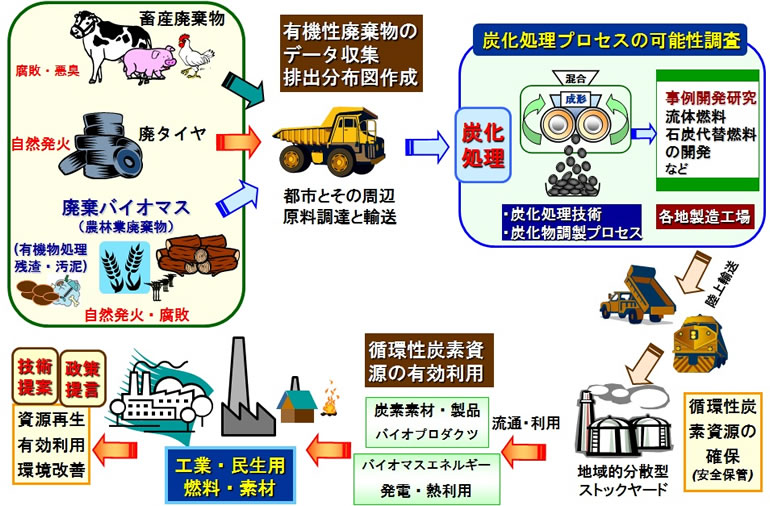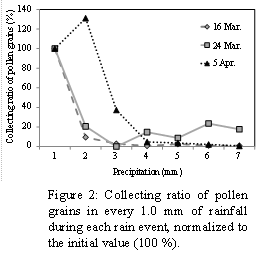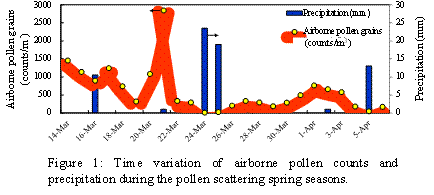
現在の研究課題
私達が住む地球の「資源エネルギー」も「環境容量」も「有限」である事を知ってしまった人類は、この「有限地球観」の土俵の中で、最善を尽くして新たな世界を模索しなければなりません。私達自身の為にも、そしてもっと大切なことは、私達の子孫の為にも...。エネルギー資源と地球環境の両分野で研究を行ってきた私には、正直言って、これは大変に困難な道程だと思います。人類の生死をかけた困難な戦いであると言っても過言ではないかも知れません。従って、人類は有りったけの知恵を絞ってこの困難に挑戦してゆかなければならないと信じます。私達は、決して、絶望しているわけではありません。絶望しているゆとりはありません。
人類が自然資源(Resources)を過度に利用して進化してきたが、それが跳ね返って、汚染発生源(Sources)として、環境に悪影響を与えてきました。適切なResourcesのクリーンな利用によって、汚染物質のSourcesを抑制して、ResourcesとSourcesを一貫して、資源・エネルギー・環境を同時に考えたプロセッシングは不可欠です。そのため、私(王教員)は、大気汚染物質の計測技術、有機資源工学、環境科学を応用する研究に重点におき、エネルギー資源と地球環境化学の両分野への実用的な研究を通じて、地域社会や国際社会へ貢献できる共同研究を積極的に行っています。また、物質循環科学の教育プログラムの担当教員として、化学を基礎とする教育をはじめ、自然との共生を考慮した資源の高効率利用技術や環境負荷の低減技術の開発、並びにその汚染物質の計測・評価に必要な専門科目を学習できるよう指導していきます。さらに、地球的・人類的スケールの視野からの社会的ニーズに応える人材を育成したいと思います。
1. 都市部に飛散する花粉とそのアレルゲン含有粒子の計測手法の開発と環境影響評価
2. 環境汚染物質の計測と発生源寄与率の評価手法
(2) 移動発生源に関連する浮遊粒子状物質の特性とソースプロフィールの開発
(3) 固定発生源における排出粒子捕集条件に関する研究
3. 都市固形有機性廃棄物の熱炭化処理システムの最適化
4. 廃棄バイオマス効率的利用システムの構築とその安全性評価
5.植物セルロースからの液化メカニズム解明とエコポリマーの開発への応用
6. エネルギーの高効率利用システムの開発
(2) 廃棄石炭のガス化転換技術に関する基礎研究
(3) バイオマス・石炭熱分解に由来するタールの新規抑制・利用技術の開発
(4) 石炭・BB燃焼灰の再利用システムの開発
研究事例1:スギ花粉およびアレルゲン含有粒子の飛散挙動及び変性
花粉症は花粉が目や鼻腔、口に侵入し、その花粉から溶出したアレルゲンが原因となって惹起される。従来、花粉は鼻腔や口よりも気道深部へは侵入しないと考えられてきたが、下気道へ侵入可能な花粉アレルゲン含有粒子の存在が明らかになり、本研究により大気汚染物質と花粉アレルゲンとの関連性、並びに花粉アレルゲンの放出機構、変性(修飾)などの新たな知見が期待されている。

研究事例2:有機性廃棄物の炭化処理、炭化物・廃棄石炭の利用技術の開発
有機性廃棄物の炭化処理と廃棄石炭の回収利用技術などをモデル事例研究とし、その利用性能と安全性を見極める。中国や東南アジア諸国において、循環性炭素資源の創出、化石資源依存エネルギー製品を、再生可能なバイオマス・非化石エネルギー化による石油・石炭化学の「機能代替」可能性を明確な形で切り拓き、次世代エネルギー確保、持続可能な社会への移行促進は国際的においても社会的要求は高い。
 ▲ このページのトップへ
▲ このページのトップへ
Modification and Transition of Airborne Japanese Cedar Pollen Contacted with Yellow Sand in Urban Atmosphere
INTRODUCTION
Cryptomeria japonica pollen, so-called Japanese cedar pollen, are scattered during each spring season. The increment of the airborne cedar pollen counts is a main nominated reason, while many other factors such as the urban environmental pollution and human lifestyle are pointed out as well. The cedar pollinosis is one of the typical allergic diseases caused by two main kinds of daughter allergens so-called Cry j 1 and Cry j 2 which exist in Japanese cedar pollen. Daughter allergenic particles are released, which are smaller in size than their parent pollen grain and are abundant in particle sizes smaller than 1.1 μm in the urban atmosphere; nevertheless, Japanese cedar pollen grain size is about 30 μm. In particular, the daily variation delays in the peaks of allergenic Cry j 1 concentrations of Japanese cedar pollen compared with the peaks of airborne pollen counts were observed in high levels during one or two sunny days after rainfall. In addition, long range transportation of Asian dust (AD) from the East Asian continent, so-called yellow sand, was also found during the pollen scattering seasons in Japan, due to global warming. Therefore, the interaction between pollen and air pollutants, including yellow sand, should be of concern. Thus, we focused on rainfall as one of impact factors to be small sized allergen containing particles.
In this study, we investigated scattering behavior of Cryptomeria japonica pollen grains and its allergenic particles in urban atmosphere. In addition, the elution behavior of allergen from pollen grains in simulated rainfall was also investigated. The good correlations between pollen counts and temperature or wind speed were indicated under calm weather with weak wind speed at night. Pollen counts were increased depending on the southerly wind. On the other hand, Cry j 1 concentrations at roadside were higher than those at 10th Floor of building differed with pollen counts. Therefore, deposited pollen grains in urban area were posed morphological change by friction of asphalt, interaction with air pollutants and so on. In other words, pollen scattering behavior on ground level in urban area was possibly underestimated by only pollen counts.
The another aim of this study is to investigate the morphological behavior of Cryptomeria japonica pollen trapped in air polluted rainwater observed through rainfall sampling in an urban polluted area. The elution of allergenic Cry j 1 contents was drastically increased when contacted with the solution containing high ionic concentration and high pH value such as rainfall water during the rainfall after long range transportation events of Asian dust. Our results from laboratory experiments indicated that elution of allergenic Cry j 1 contents was increased when contacted with the solution containing high ionic concentration such as initial rain water. Moreover, we succeeded in detecting allergenic Cry j 1 containing 3-nitrotyrosine (3-NT) in the atmosphere for the first time in the world as the probable evidence of chemical modification of allergenic Cry j 1 by air pollutants emitted from motor vehicle, and quantity of airborne allergenic Cry j 1 containing 3-NT were observed highly in the particle sizes smaller than 1.1 mm and from 3.3 mm to 7.0 mm compared with larger than 7.0 mm.
METHODS
Sampling and determination of pollen grains and Cry j 1 in SPM during pollen scattering season
From March 26th to ~ April 8h May in 2011, airborne pollens and allergenic particles were collected at Saitama University campus in the urban of Saitama city, located in the Kanto Plain, Japan. Two automatic pollen monitors (Model KH3000-01, Yamatronics Co. Ltd.), which is a device counting the number of the particles of 28-35μm equivalent to cedar and cypress pollen by the air light automatically, were embarked on collection for pollen counts during the daytime (8:00 ~ 20:00) and the nighttime (20:00 ~ 8:00) at roadside and 10th floor of building of Research and Project. We collected SPM on tissue-quartz filters (8 mmf) by using two high volume Andersen air samplers (Model AH-600, Shibata Co. Ltd.) in five particle sizes (<1.1, 1.1~2.0, 2.0~3.3, 3.3~7.0, >7.0 mm) in atmosphere. To measure pollen allergenic Cry j 1 concentrations, each filter sample was put in test tube with 2 mL HBS-EP buffer solution, and these test tubes were put at 4 °C for 3 hours. Cry j 1 concentration were determined using a Biacore J system (GE health care Japan Co., Ltd.) based on the surface plasmon resonance (SPR) method mentioned in our previous study.
Investigation of trapping counts and morphological behavior of Cryptomeria japonica pollen grains in urban polluted rainwater
Rainfall samples were collected with a rainwater sampler called Rain-go-round (Horiba, Co., Ltd.). This apparatus can partially collect rainwater from 1 to 7 mm of rainwater, collecting 5 mL per one mm rainwater from every event. The sampling site was chose carefully in order to block the influx of raindrops by the roof of buildings or trees. The collected rainwater samples were respectively set in micro tubes and centrifugally separated at 6,000 rpm for 10 min. Then, the supernatants were set in a polyethylene bottle. Supernatants and residues were stored at 4 °C until analysis.
Burst of pollen grains in residue were counted separately from non-burst pollen grains by using an optical microscope (Shimadzu Co., Ltd.) at 150 magnifications. Pollen on each slide was counted twice, and finally average and standard deviation were calculated. Concentrations of ionic species and pH in rainwater were measured from the supernatants. The pH was measured with a pH meter B-212 (Horiba Co., Ltd.). Ionic concentrations of Cl-, NO3-, SO42-, Ca2+, Na+, Mg+ and NH4+ were measured by an ion chromatography (DX-100, Dionex Co., Ltd.).
Laboratory elution experiments of Cryptomeria japonica pollen grains
In order to investigate the elution mechanism of allergenic species fromCryptomeria japonica pollen grains, simulated rainwater samples in reference to our sampling result and data reported by other researchers1) were prepared by changing the pH and ionic concentrations in different solutions. Initial rainwater samples (IR) were used, because pollen grains were abundantly trapped into initial rainfall. Simulated rainwater samples (SR) were prepared based on the pH and ionic concentrations of rainwater samples determined during the field sampling period in Saitama, Japan. Initial rainwater samples when AD was observed (IR-AD) were also prepared, because pH and ionic concentrations in rainwater increased considerably due to trapped AD in it.
Allergenic Cry j 1 concentrations in measured samples were investigated based on Cry j 1 monoclonal antibody (MAb) immobilized on a CM5 sensor chip by using the SPR method with the Biacore J system. Approximately 700 μg of Cry j 1 MAb was immobilized on the chip. The regeneration and dissociation of antigen-antibody complex reaction on the CM5 sensor chip were performed by 70 μL of pH 2.0 glycine-HCl (GE Healthcare Co., Ltd.). The analysis was repeated three times (n=3) for each sample for better accuracy. Finally, the results were converted into the concentrations of the allergenic Cry j 1 eluted from 1.00 mg pollen grains (μg/mg) in mass.
Measurement of relative quantity of Cry j 1 containing 3-NT by the enzyme-linked immunosorbent assay (ELISA method)
The analytical procedure of allergenic Cry j 1 containing 3-NT has not been developed because standard sample of Cry j 1 containing 3-NT isn’t marketed and its purification is difficult. In this study, the particle size distribution of relative quantity of Cry j 1 containing 3-NT was evaluated by the absorbance differences between ELISA samples and blank sample (PBS solution).
RESULTS AND DISCUSSION
Relationship between airborne pollen counts and weather conditions
The tendencies of airborne pollen counts were investigated in the daytime and nighttime. Comparing with wind speed, wind directions, normal temperature, and precipitation in the sampling period, the scattering tendencies of cedar pollen was observed almost same on a roadside and 10th floor of building of Research and Project. Airborne pollen counts on 10th floor of building of Research and Project were higher level than ones on the roadside. On the other hand, correlations were not found by airborne pollen counts since the air flow of scattering pollen sources were different during both of the daytime and nighttime. This is considered to be caused by different wind directions during the daytime and nighttime. Even if the southerly wind blew in the daytime, the wind directions served as the northerly wind in the nighttime.
Counting number of trapped pollen grains in rainwater

 Figure 1 shows the time variation of airborne pollens and precipitation during spring 2010. Airborne pollen grains counts decreased with rainfall events. There were also days when non-decreasing counts of airborne pollen grains during rainfall events were observed, in these days rained at nighttime when pollen grains were less scattered. During the spring period, rainwater samples were collected 4 times in 16 March (10.5 mm), 21 March (only 1.0 mm), 24 March (24 mm) and 5 April (13 mm). Additionally, figure 2 indicates the collected ratio of pollen grains in every 1.0 mm of rainfall during each rainfall event, normalized to the initial value (100 %), therefore, the 1.0 mm rainfall on 21 March, cannot be shown in figure 2. The highest standard deviation of pollen counts in rainwater was 14 %. Most pollen grains were trapped into initial rainfall, with exception of 5 April when pollen grains trapped into the second 1.0 mm of rainfall rather than the first 1.0 mm. In this day, initial rainfall was light rain, 0.5 mm/h, then, airborne pollen grains could not be completely trapped into the initial rainfall. From this result, it was demonstrated that most pollen grains were trapped into initial rainfall.
Figure 1 shows the time variation of airborne pollens and precipitation during spring 2010. Airborne pollen grains counts decreased with rainfall events. There were also days when non-decreasing counts of airborne pollen grains during rainfall events were observed, in these days rained at nighttime when pollen grains were less scattered. During the spring period, rainwater samples were collected 4 times in 16 March (10.5 mm), 21 March (only 1.0 mm), 24 March (24 mm) and 5 April (13 mm). Additionally, figure 2 indicates the collected ratio of pollen grains in every 1.0 mm of rainfall during each rainfall event, normalized to the initial value (100 %), therefore, the 1.0 mm rainfall on 21 March, cannot be shown in figure 2. The highest standard deviation of pollen counts in rainwater was 14 %. Most pollen grains were trapped into initial rainfall, with exception of 5 April when pollen grains trapped into the second 1.0 mm of rainfall rather than the first 1.0 mm. In this day, initial rainfall was light rain, 0.5 mm/h, then, airborne pollen grains could not be completely trapped into the initial rainfall. From this result, it was demonstrated that most pollen grains were trapped into initial rainfall.
Ionic concentrations in different rain events
Ionic concentrations decreased with increasing precipitation. AD was observed in 20 March in Japan. Thus, AD was trapped into rainfall the next day, and ionic concentrations became higher than rainfall in other days. Especially, mineral ions such as Ca2+ derived from AD and/or road dust drastically increased about 2.5 times. From our previous report2), elution concentration of Cry j 1 increased by solutions containing high ionic concentrations under weak basic conditions. Therefore, it suggested that elution of daughter allergenic species were induced by rainfall trapping of crustal particles.
Influence of pH on burst of pollen grains trapped into rainwater samples
Since elution of Cry j 2 was induced by burst of pollen grains in contact with basic solutions in our previous study, we thought that elution of Cry j 2 was strongly depending on solution pH.
Therefore, in our study, we  investigated the burst ratio of pollen grains related with pH. Figure 3 indicates the correlation between pollen burst ratios and pH in rainwater. The data at 3rd mm of rainwater in 24 March was eliminated, because there were no pollen grains trapped in rainwater. Despite of a better correlation (R = 0.61, p < 0.001), the burst ratio of pollen grains was only 30 % in weak basic rainwater. Therefore, we think that the burst of pollen grains might be also induced by other influence factors. Scattering of AD was observed in 20 March, while our samples indicated that AD was trapped into rainfall in 21 March. Most pollen grains were burst in rainwater in 21 March. Rainfall trapping AD was reported to increase pH above 7.0, and pH in rainwater in 21 March also increased. From this result, we thought that the burst ratio of pollen increased with increasing pH. Therefore, it is possible that rainfall trapping AD is one of important factor that affects the release the pollen allergenic species
investigated the burst ratio of pollen grains related with pH. Figure 3 indicates the correlation between pollen burst ratios and pH in rainwater. The data at 3rd mm of rainwater in 24 March was eliminated, because there were no pollen grains trapped in rainwater. Despite of a better correlation (R = 0.61, p < 0.001), the burst ratio of pollen grains was only 30 % in weak basic rainwater. Therefore, we think that the burst of pollen grains might be also induced by other influence factors. Scattering of AD was observed in 20 March, while our samples indicated that AD was trapped into rainfall in 21 March. Most pollen grains were burst in rainwater in 21 March. Rainfall trapping AD was reported to increase pH above 7.0, and pH in rainwater in 21 March also increased. From this result, we thought that the burst ratio of pollen increased with increasing pH. Therefore, it is possible that rainfall trapping AD is one of important factor that affects the release the pollen allergenic species
Elution of daughter allergenic species derived from pollens contacted with simulated rainwater
Based on the fact that the content of Cry j 1 in Cryptomeria japonica pollen is 435 ± 169 ng/mg, it was estimated that elution ratio of Cry j 1 was 3.8 % in IR-AD, 0.6 % in IR and 0.4 % in SR respectively. From some reports of scattering counts of Cryptomeria japonica pollens in Japan2), weight of pollen grain3) and contained amount of Cry j 1, it was estimated that Cry j 1 was eluted with 1.3, 0.9, 8.3 pg/m3 by IR, SR and IR-AD respectively. Therefore, worsening asthmatic symptoms may associate with the generation of small-sized allergenic species induced by rainfall and exposed to polluted air, especially AD.
Size distribution of relative quantity of allergenic Cry j 1 containing 3-NT in urban atmosphere
Airborne allergenic Cry j 1 containing 3-NT were mainly detected in the particle sizes smaller than 1.1 mm and from 3.3 mm to 7.0 mm compared with larger than 7.0 mm. The quantities of airborne allergenic Cry j 1 containing 3-NT per Cry j 1 unit quantity were observed highly in the particle sizes smaller than 1.1 mm and from 3.3 mm to 7.0 mm compared with larger than 7.0 mm.
CONCLUSIONS
In this study, we investigated the release behavior of daughter allergenic species from Cryptomeria japonica pollen grains trapped in rainfall and exposed to polluted air. From our results of rainfall sampling, most airborne pollen grains were trapped in initial rainwater. The ionic concentrations in initial rainfall were higher than the following one, because air pollutants were only abundantly trapped in initial rainfall. In conclusion, there may be two processes for release of Cryptomeria japonica pollen allergenic species related with air polluted wet deposition. One is the elution of allergenic species (mainly Cry j 1) from pollen grain surface by contact with rainwater, and the other is the release of allergenic species (both of Cry j 1 and Cry j 2) from burst pollen grains when trapped in rainwater. Airborne allergenic Cry j 1 containing 3-NT was observed highly in fine particles.
REFERENCES
- Kawamura, C et al., (2006). Influence of Kosa in precipitation chemistry in Japan, Japan Society for Atmospheric Environment, 41(6), 335-346 (in Japanese).
- Wang, Q. et al., (2012). Release behavior of small sized daughter allergens from Cryptomeria japonica pollen grains during urban rainfall event, Aerobiologia, 28, 71-81.
- Ohashi, E. et al., (2001). Indoor air-pollution by Japanese cedar pollen (2): measurement of particle diameter and weight of cedar pollen, and its aerodynamic diameter, Report of Architectural Institute of Japan, 939-940, (in Japanese).
